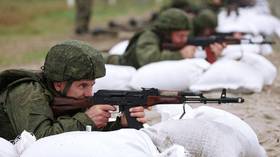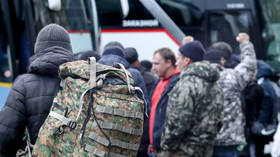Putin explains mobilization figures

The Russian military swelled its ranks by more than the expected 300,000 during the mobilization drive, Russian President Vladimir Putin has revealed. The call-up was ordered by the president in September amid the ongoing conflict in Ukraine.
Putin commented on the matter on Friday after a flower-laying ceremony in Moscow marking Unity Day. “We already have 318,000 [mobilized reservists]. Why 318,000? – Because volunteers are coming,” the Russian president explained, adding that the “number of volunteers is not going down.”
The partial mobilization in Russia began on September 21. The Defense Ministry said at the time that it planned to boost the strength of the existing army by calling up reservists.
According to Putin’s latest remarks, 49,000 of the draftees are already on the frontlines in Ukraine, while the rest are still undergoing training.
The Russian president also insisted that the “state was doing everything to support” the families of those reservists and praised volunteer movements that were doing the same.
Putin announced the end of the partial mobilization on Monday.
Russia sent troops into Ukraine on February 24, citing Kiev’s failure to implement the Minsk agreements, designed to give the regions of Donetsk and Lugansk special status within the Ukrainian state. The protocols, brokered by Germany and France, were first signed in 2014. Former Ukrainian president Pyotr Poroshenko has since admitted that Kiev’s main goal was to use the ceasefire to buy time and “create powerful armed forces.”
In February 2022, the Kremlin recognized the Donbass republics as independent states and demanded that Ukraine officially declare itself a neutral country that will never join any Western military bloc. Kiev insists the Russian offensive was completely unprovoked.
In early October, the Donetsk and Lugansk People’s Republics, as well as Zaporozhye and Kherson Regions, officially became part of Russia following referendums that saw the majority of local residents vote in favor of the accession.












